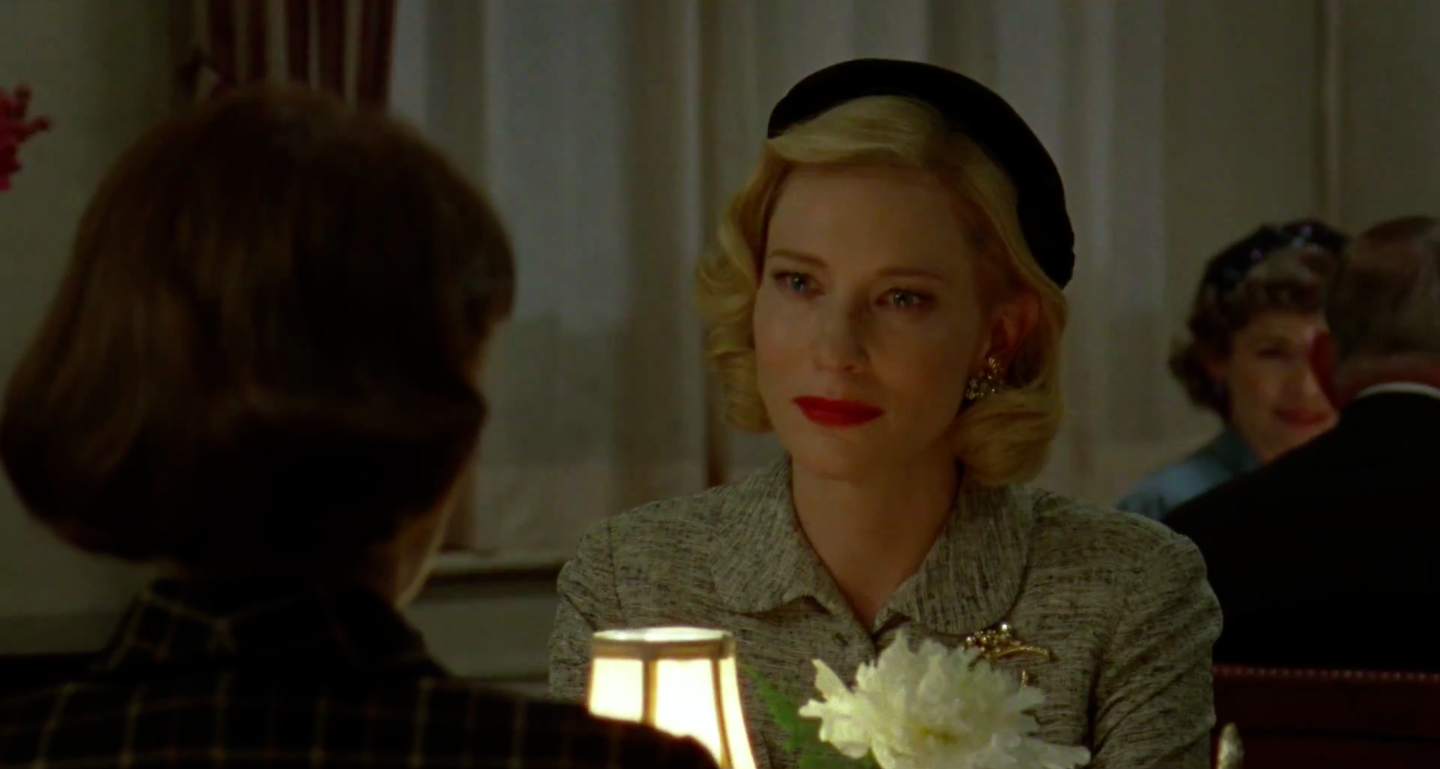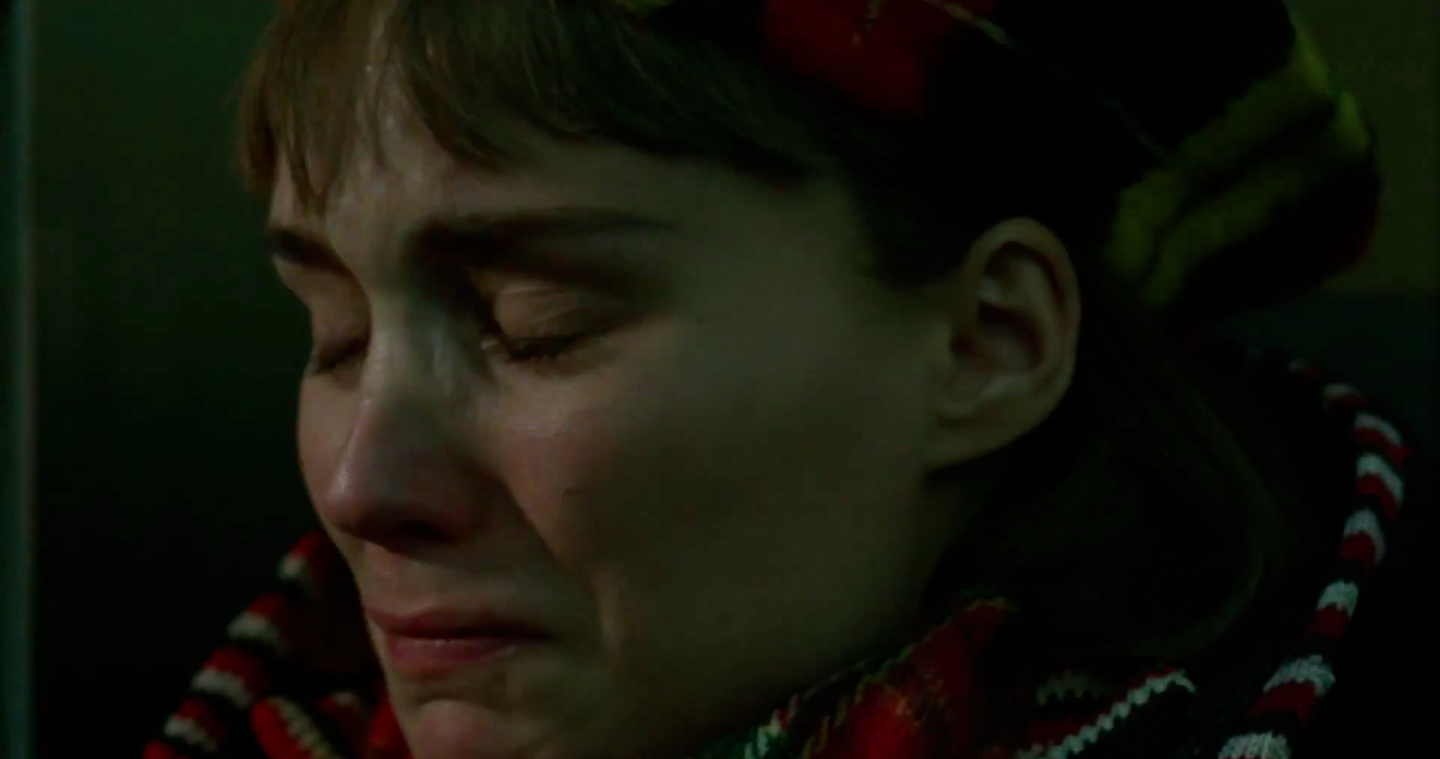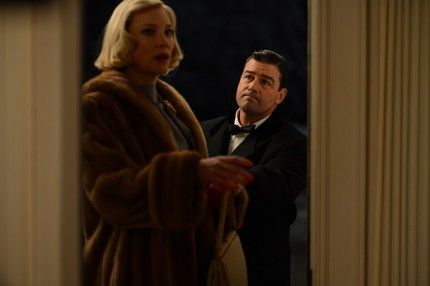I am so conflicted about this movie. it is sitting on top of many critics best of the year list, Cate Blanchett is almost certainly going to win an Oscar for her titular role, and while I don’t think it is necessarily a bad movie I am certainly unconvinced of its apparent brilliance.
 Carol is a fictional story based upon a novel written by Patricia Highsmith. This is the same author who wrote The Talented Mr. Ripley and Strangers on a Train. The novel, “The Price of Salt” was written under a pseudonym, Claire Morgan, perhaps because Highsmith was concerned about the backlash of writing a lesbian love story in 1952, but almost certainly because she drew so much of the meat of the story from her own life. Read how The New Yorker tells the story behind the story.
Carol is a fictional story based upon a novel written by Patricia Highsmith. This is the same author who wrote The Talented Mr. Ripley and Strangers on a Train. The novel, “The Price of Salt” was written under a pseudonym, Claire Morgan, perhaps because Highsmith was concerned about the backlash of writing a lesbian love story in 1952, but almost certainly because she drew so much of the meat of the story from her own life. Read how The New Yorker tells the story behind the story.
December of 1948, Patricia Highsmith was a twenty-seven-year-old aspiring writer with a murderous imagination and an outsized talent for seducing women. Her first novel, “Strangers on a Train,” was complete, but it would be more than a year before it was published. A Texas native with thick black hair and feral good looks, Highsmith made a habit of standing at attention when a woman walked into the room. That Christmas season, she was working behind the toy counter at Bloomingdale’s, in Manhattan, in order to help pay for psychoanalysis. She wanted to explore the sharp ambivalence she felt about marrying her fiancé, a novelist named Marc Brandel. Highsmith was a Barnard graduate, and, like many sophisticates at the time, she viewed homosexuality as a psychological defect that could be fixed; yet she had enough self-respect and sexual appetite to reject any attempt to fix her own. When her analyst suggested that she join a therapy group of “married women who are latent homosexuals,” Highsmith wrote in her diary, “Perhaps I shall amuse myself by seducing a couple of them.” She never married Brandel—or anyone else.
One day, a woman in a mink coat drifted into the toy department. Highsmith later recalled, “Perhaps I noticed her because she was alone, or because a mink coat was a rarity, and because she was blondish and seemed to give off light.” Like Alfred Hitchcock, Highsmith was captivated by frosty blondes, all the more so if they were married and rich. The shopper, who slapped her gloves into one hand as she scanned the merchandise, made Highsmith feel “odd and swimmy in the head, near to fainting yet at the same time uplifted.” With an abstracted air, the woman, Mrs. E. R. Senn, bought a doll from Highsmith.
That night, Highsmith wrote an eight-page outline for a novel: a love story about Therese Belivet, a diffident nineteen-year-old who lives on her own in New York City, and Carol Aird, a wealthy suburban wife and mother in her thirties. Highsmith conjured what Therese would feel upon catching her first glimpse of Carol: “I see her the same instant she sees me, and instantly, I love her. Instantly, I am terrified, because I know she knows I am terrified and that I love her. Though there are seven girls between us, I know, she knows, she will come to me and have me wait on her.”
 So you now know the basic story behind Carol. A doe-eyed young shopgirl struggles with her identity as she befriends and begins to fall in love with an upper-class older woman going through a difficult divorce. It is such a simple premise for a film, and in today’s world of legalized gay marriage and homosexual characters on seemingly every television show it could have felt trite and boring. But this is not a 2016 retelling of a 1950s story. This is a 1950s film, and if we were able to take a Delorean back to 1955 and present Carol it would be apparent that this film is right on the cutting edge.
So you now know the basic story behind Carol. A doe-eyed young shopgirl struggles with her identity as she befriends and begins to fall in love with an upper-class older woman going through a difficult divorce. It is such a simple premise for a film, and in today’s world of legalized gay marriage and homosexual characters on seemingly every television show it could have felt trite and boring. But this is not a 2016 retelling of a 1950s story. This is a 1950s film, and if we were able to take a Delorean back to 1955 and present Carol it would be apparent that this film is right on the cutting edge.
I have told my wife while playing those silly would you rather type games that if given the choice of just about any era in history, I think I might step into the 1950s. It was such an elegant time. Everything was ordered and in its place. We had just won World War II and the country was in a time of growth and prosperity. There were values which governed the society. I think of The Andy Griffith show and Leave it to Beaver. I think I could have fit very well in that time period. However, I also know that the image that I have of that time is completely created by Hollywood and television. I don’t know what it was like to really live in that environment, but I can only imagine that with the hard swing that the culture took in the 1960s that the 1950s were working too hard to keep everyone confined in their perfectly manicured and carefully constructed social norms.
 I’m not sure why this movie is titled Carol. To me, Carol (Cate Blanchett) had a much less interesting role in the film than that of Therese (Rooney Mara). Therese grows before our eyes while Carol is set in her ways before we ever meet her. Certainly, both characters stories unfold before us throughout the film, but if I had to pick a lead and supporting character, I’m choosing Therese as the lead. I mean there is no doubt that the author placed herself in the story as her. And although Carol suffers more dramatic hurdles and setbacks I felt much more connected to Therese and her internal struggle.
I’m not sure why this movie is titled Carol. To me, Carol (Cate Blanchett) had a much less interesting role in the film than that of Therese (Rooney Mara). Therese grows before our eyes while Carol is set in her ways before we ever meet her. Certainly, both characters stories unfold before us throughout the film, but if I had to pick a lead and supporting character, I’m choosing Therese as the lead. I mean there is no doubt that the author placed herself in the story as her. And although Carol suffers more dramatic hurdles and setbacks I felt much more connected to Therese and her internal struggle.
I always feel like I have missed something whenever I go so strongly against the grain of other film critics, but in this case I have to say that I did not feel a great deal of chemistry between Mara and Blanchett. I could see the tortured look on Mara’s face as she struggled with her identity but I did not see any of the attraction that was supposed to lie beneath that struggle. I could look at the pained and frustrated expressions on the face of, Carol’s soon to be ex-husband, Harge and I was there I could feel his struggle to love and difficult woman who is slipping away from him. It baffles me to think that Cate Blanchett nearly has this Oscar in the bag for a role that felt very phony to me. In fact, everything else in the film feels ultra realistic, but the titular character left me feeling flat.
The first hour of this film feels so slow and deliberate with almost exclusive use of motionless camera shots, wide pans, combined with drastic closeups. This was very intentional by Director Todd Haynes, who previously filmed this era with a keen eye in Far from Heaven. But this dramatic shift in pace takes a while to get used to. I found myself feeling kind of bored and was itching to check my phone or something, but it struck me that Haynes was purposefully trying to bring the viewers into the 1950s even if for just a few hours. Not just through set design which was superb but in pacing and feel. This was a time without television, internet, and mobile devices, an age where an electric train set or a hand-painted porcelain doll was the Christmas gift of choice. Much of the film would be spent in silence were in not for the ethereal quality of the soundtrack provided by the illustrious Carter Burwell. There is not a lot of dialogue, mostly long shots of faces and reactions, glances and lingering touches. I felt it was appropriate that the studio created a beautiful wordless trailer for the film. It really seems to fit the film and encapsulates the desire of the film maker.
https://www.youtube.com/watch?v=bF1YIF_FknI
However, as beautiful as this film was. I can’t help but think that Haynes did not go far enough. I wish that he had gone the whole way and made a film that might have passed the 1950s Hays code. The scene in the department store is nearly perfect. These two ladies are connected by a glance and it is broken too quickly. There is an awkward conversation about a girl who didn’t play with dolls and the purchase of a train set as a Christmas present for a little girl. I wish the film would have left us in that 1950s world instead of giving us a completely unnecessary shot of Rooney Mara having her shirt pulled open. Perhaps I am far too old fashioned, but I just miss the days when there were things that were considered taboo. And it took a very deft director’s hand to carefully navigate and hint at something as taboo as a lesbian love story. Unfortunately, we live in an anything goes type of climate today and after the first hour of navigating awkward conversations and couples fighting about former relationships I thought that Haynes might just produce a subtle and authentic period piece which addressed the elephant in the room without shooting him dead. But instead, I’m just left longing for Audrey Hepburn, Lauren Bacall, Bette Davis, and Jimmy Stewart.

I have been surfing on-line greater than 3 hours today, yet I
never discovered any fascinating article like yours.
It is pretty value enough for me. Personally, if all web owners and bloggers made good content as you did, the internet might be
much more helpful than ever before.